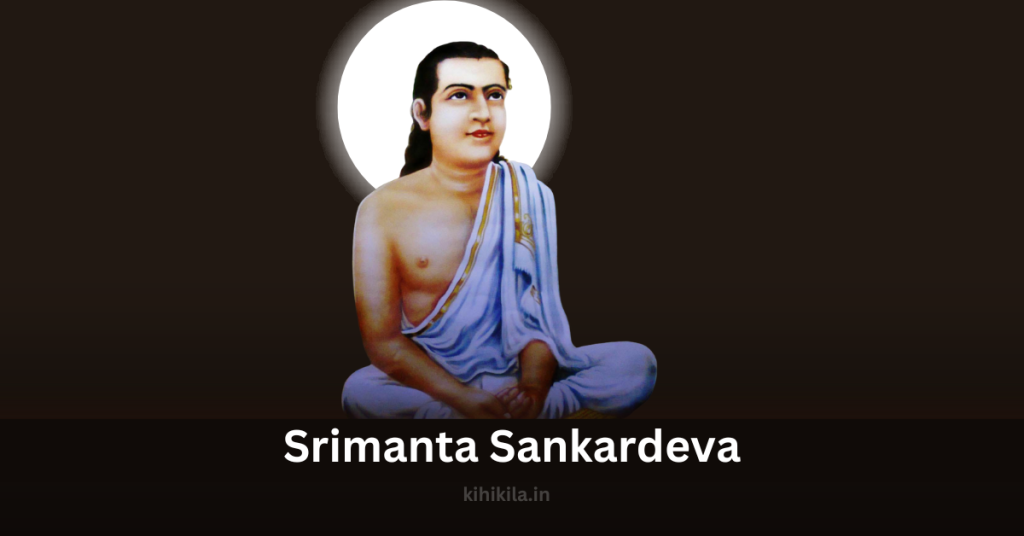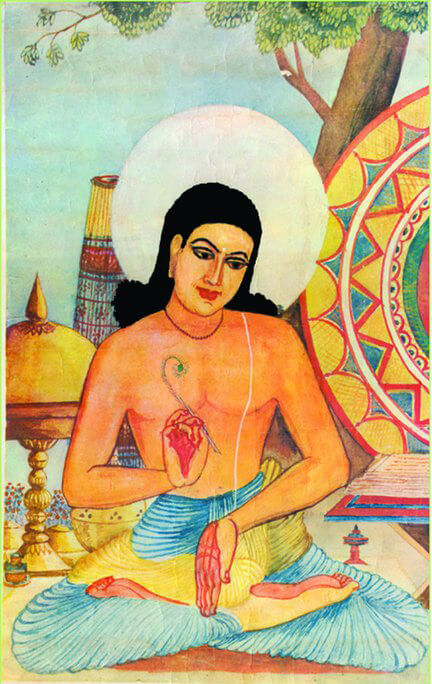Early Life and Education
Srimanta Sankardeva, one of the greatest spiritual reformers of Assam, was born in 1449 in the Baro-Bhuyans family at Aali-Pukhuri, near Bardowa in the Nagaon district. The Baro-Bhuyans were independent landlords belonging to the Kayastha Hindu caste. His parents, Kusumvar Barbhuyan and Satyasandhya Devi, passed away when he was very young, leaving him in the care of his grandmother, Khersuti.
Sankardeva’s education began at the age of 12 under the guidance of the renowned scholar Mahendra Kandali. His intellectual brilliance became evident when he composed his first verse, “Karatala Kamala Kamaladala Nayana…”, even before fully learning the vowels. He was not only an exceptional student but also physically adept—he could swim across the mighty Brahmaputra during its peak flow.
Rise as a Spiritual Leader
At the age of 21, Sankardeva left school to assume his responsibilities as Shiromani Bhuyan (leader of his clan). However, his spiritual quest soon took precedence. He moved to Bordowa, where he composed Harishchandra Upakhyan, his first literary work. During this time, he also staged Cihna Yatra, one of the first open-air theatrical performances in the world. He personally painted the Sapta Vaikuntha (Seven Heavens), designed musical instruments, and directed the entire production, marking the beginning of Assamese drama and performing arts.

Pilgrimage and Religious Awakening
Following the untimely demise of his first wife, Suryavati, Sankardeva’s spiritual inclinations deepened. At the age of 32, he embarked on a 12-year pilgrimage across India, visiting sacred sites like Puri, Mathura, Dwarka, Vrindavan, Ayodhya, and Rameswaram. During this journey, he encountered the Bhakti movement, which deeply influenced his ideology.
At Badrikashrama, he composed his first Borgeet, “Mana meri Ram charanahi lagu.” Upon returning home, he declined the Shiromaniship, choosing instead to spread the principles of Eka-Sarana-Hari-Nama-Dharma—a monotheistic Vaishnavism centered around devotion to Lord Krishna.
Establishment of Neo-Vaishnavism in Assam
Sankardeva’s teachings emphasized devotion (bhakti) over rituals, rejecting idol worship and caste distinctions. His Naamghar (prayer hall) became the central place for congregational worship. He composed Bhakti Pradipa and Rukmini Harana, further propagating his ideals. He also started translating the Bhagavata Purana into Assamese, making spiritual knowledge accessible to the common people.
During his time at Dhuwahat, he met Madhavadeva, a staunch Shakta follower who later became his most devoted disciple. Their legendary debate led to Madhavadeva’s conversion to Vaishnavism, strengthening the spread of Sankardeva’s teachings.
Struggles and Persecution
Despite his growing influence, Sankardeva faced resistance from Brahmins who saw his reformist ideas as a threat. Complaints were lodged against him with the Ahom king, Suhungmung. Though he and his disciples successfully defended themselves, tensions with the ruling class persisted. His son-in-law, Hari, was executed, and Madhavadeva was imprisoned for a year. This tragedy deeply affected Sankardeva, prompting him to relocate to the Koch kingdom.
In 1568, at the age of 120, Srimanta Sankardeva passed away at Bheladonga, leaving behind an unparalleled spiritual and cultural legacy.
Literary Contributions
Kavya (Poetic Works):
- Kirtana-Ghosha
- Harischandra-Upakhyana
- Rukmini-Harana
- Ajamilopakhyana
- Bali-Chalana
- Kurukshetra-Yatra
- Gopi-Uddhava-Samvada
- Amrta-Manthana
- Krishna-Prayana-Pandava-Niryana
- Kamajaya
Bhakti Theory:
- Bhakati-Pradipa
- Anadi-Patana
- Nimi-Navasiddha-Samvada
- Bhakti Ratnakara (Sanskrit)
- Gunamala
Drama (Ankia Nat):
- Cihna Yatra (lost)
- Patni-Prasada
- Kalia-Damana
- Keli-Gopala
- Rukmini-Harana
- Parijata-Harana
- Srirama-Vijaya
Cultural Impact
Sattriya Dance
Sankardeva pioneered Sattriya, a classical dance form that was preserved for centuries in the monasteries (Sattra) of Assam. This dance, now recognized as one of India’s eight classical dance forms, continues to be performed in naamghars and cultural festivals.
Borgeets
He composed Borgeets (devotional songs) in Brajavali, blending Assamese and Maithili influences. These songs remain an integral part of Assamese religious and cultural life.
Visual Arts
His Vrindavani Vastra, a grand tapestry depicting Lord Krishna’s exploits, was woven in Assam and is now preserved in London. He also created the Sapta Vaikuntha paintings for Cihna Yatra, though they no longer exist today.
Srimanta Sankaradeva’s Legacy
Srimanta Sankaradeva Sangha
Established in 1930, this organization continues to spread his teachings, emphasizing equality, devotion, and the eradication of caste-based discrimination.
Srimanta Sankaradeva Kalakshetra
This cultural institution in Assam showcases the state’s rich heritage, echoing Sankardeva’s vision of unity and artistic excellence.
Conclusion
Srimanta Sankardeva was more than just a saint—he was a visionary, poet, artist, playwright, and social reformer. His contributions to Assamese culture, literature, and spirituality remain unparalleled. By promoting devotion over rituals, fostering unity among different communities, and revolutionizing Assamese literature and performing arts, he shaped the identity of Assam like no other.
His teachings continue to guide millions, and his influence on Assam’s social and cultural fabric is everlasting. Even today, his naamghars, songs, dramas, and philosophies inspire people to embrace a life of devotion, simplicity, and harmony.
FAQ’s:
Q 1. Who was Srimanta Sankardeva?
Srimanta Sankardeva was a great saint, social reformer, poet, playwright, and cultural icon from Assam. He introduced the Neo-Vaishnavism movement in Assam, emphasizing devotion to a single God, Lord Krishna. His teachings helped remove caste barriers and brought people together through faith, art, and literature.
Q 2. Where was Srimanta Sankardeva born?
He was born in 1449 in Alipukhuri, a village near Bardowa in Nagaon district, Assam. He belonged to the Baro-Bhuyan family, a group of independent landlords.
Q 3. What was the significance of the Bhakti movement led by Srimanta Sankardeva?
His Bhakti movement promoted equality, devotion, and the worship of one supreme God. It opposed idol worship and caste discrimination, making religion accessible to all, regardless of background. His teachings still influence Assamese society today.
Q 4. What is Eka-Sarana-Hari-Nama-Dharma?
Eka-Sarana-Hari-Nama-Dharma is the religious philosophy introduced by Srimanta Sankardeva. It teaches complete devotion to Lord Krishna as the one supreme God and emphasizes naam (chanting His name) as the path to spiritual enlightenment.
Q 5. What literary works did Srimanta Sankardeva write?
He wrote many religious and literary works in Assamese and Brajavali, including Kirtana Ghosha, Harischandra Upakhyana, Rukmini Harana, and Ajamilopakhyana. He also translated parts of the Bhagavata Purana and Ramayana. His works continue to inspire spiritual and literary studies.
Q 6. What is the significance of Naamghar and Kirtanghar?
Naamghar (prayer hall) and Kirtanghar (house of devotional songs) were established by Srimanta Sankardeva as community spaces for worship, singing hymns, and spiritual discussions. They remain an integral part of Assamese religious and social life.
Q 7. How did Srimanta Sankardeva contribute to art and culture?
Apart from religious teachings, he revolutionized Assamese culture by creating Borgeets (devotional songs), Ankiya Naat (one-act plays), and Sattriya dance, which later became one of India’s classical dance forms. His works blend music, drama, and storytelling to spread spiritual messages.
Q 8. What was the role of Madhavadeva in Sankardeva’s movement?
Madhavadeva was Srimanta Sankardeva’s most devoted disciple and played a crucial role in spreading his teachings. Initially a follower of Shakta traditions, he was convinced by Sankardeva’s philosophy and later became a key figure in the Neo-Vaishnavism movement, writing several hymns and texts.
Q 9. Why did Srimanta Sankardeva oppose idol worship?
He believed that God exists within all living beings, and devotion should come from the heart rather than rituals. His philosophy focused on direct worship through naam (chanting) and devotion rather than worshipping idols.
Q 10. What is Srimanta Sankardeva’s legacy today?
His teachings continue to influence Assam’s spiritual, cultural, and social life. Naamghars are still central to Assamese communities, Sattriya dance has gained national recognition, and his literary works remain widely studied. His impact is seen in Assam’s unity, cultural richness, and deep-rooted Bhakti traditions.




